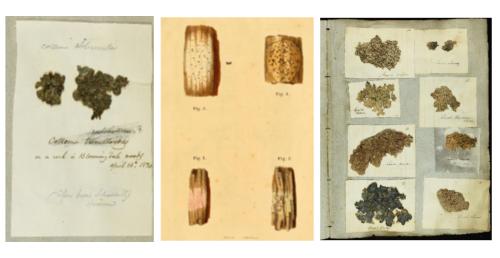LOST LICHEN SPECIMENS REDISCOVERED BY STATE MUSEUM BOTANIST OFFER A LOOK INTO NEW YORK CITY’S 19TH-CENTURY ECOLOGY
Media Contact:
JP O’Hare
(518) 474-1201
Press@nysed.gov
www.nysed.gov
Includes Specimens Originally Collected in Manhattan in 1823

Additional high resolution photos available here
A historically significant collection of lichen specimens believed to have been lost to an 1866 fire was recently rediscovered by Dr. James Lendemer, curator of botany at the New York State Museum. The serendipitous find will allow scientists to reliably reconstruct pre-industrial lichen communities from New York City, a task that up until now was not thought to be possible.
The specimens, collected in Manhattan more than 200 years ago by naturalist Abraham Halsey, provide a rare glimpse into the city's 19th-century environment and its dramatic transformation. The discovery, which took place at the Brooklyn Botanic Garden herbarium, is detailed in full by Dr. Lendemer in the December issue of the Journal of the Torrey Botanical Society.
“This discovery not only brings a pioneering naturalist's work back into the light but also provides critical insights into how human activities have reshaped New York's urban ecosystems,” said Dr. Lendemer. “This research serves as a powerful reminder of the incredible impact of museum collections. They are more than relics—they are a bridge that connects us to the past and helps us understand the pressing challenges of the present. It’s a call to action for preserving, digitizing, and restudying these irreplaceable scientific resources.”
Abraham Halsey published the first checklist of New York City lichens in 1823. It was the first work focused on lichens in North America and one of the earliest botanical works published in America. Halsey’s original collection, paired with Dr. Lendemer’s meticulous research, demonstrates significant ecological change.
In 1823, New York City’s lichen community thrived with 129 documented species, while just 18 of those species remain today. The findings highlight how human development has led to declines in many native species and ecosystems, transforming the natural landscape into a human one where biodiversity must rapidly adapt and evolve to persist.
“This study on Halsey's historic lichen collection represents an invaluable contribution to our understanding of New York's ecological history,” said Dr. Robert Feranec, Director of Research and Collections at the New York State Museum. “It not only updates Halsey's original checklist but also underscores the importance of preserving and studying our natural history collections, which hold the power to reveal just how much we've lost.”
The research also illuminates Halsey's remarkable personal journey—a naturalist who faced significant financial hardship yet remained committed to his botanical work. Against all odds, he documented a world that was already beginning to disappear, leaving behind a critical baseline for future scientists like Dr. Lendemer.
About the Cultural Education Center
Established in 1836, the New York State Museum is the oldest and largest public museum in the United States. Home to leading scientists, historians, archeologists, and anthropologists, its collections represent the State’s rich cultural and natural heritage from the past and present, including a staggering 20+ million artifacts spanning 480 million years ago to today. Located at 222 Madison Avenue in Albany, the Museum is open Tuesday through Sunday from 9:30 a.m. to 5 p.m. It is closed on the Fourth of July, Thanksgiving, Christmas, and New Year's Day. Admission is free. For additional information, visit the New York State Museum website.
The New York State Library is part of the Office of Cultural Education within the New York State Education Department. Visit the New York State Library website for a complete list of upcoming programs. To receive news, resources, and other updates, please subscribe to the quarterly newsletter.
The New York State Archives holds many of the oldest and most important archival treasures in the nation. The Archives preserves and makes accessible over 250 million records of New York’s State and colonial governments dating from 1630 to the present. The State Archives provides free access to photographs, artifacts, documents, manuscripts, and other materials that tell the story of New York’s history via its Digital Collections on the Archives website.
The Archives Partnership Trust was founded in 1992 to build an endowment and provide project support to enhance humanities programs, increase access to these outstanding treasures, and continue the preservation of New York's historical records. Since its founding, the Partnership Trust, a 501(c)(3) non-profit organization, has supported exceptional projects and programs. These include the Research Residency Program, the Student Research Awards Program, history conferences, special exhibitions, public education programs, book signings and lectures, publications, teacher training institutes, preservation projects, and more.
The State Museum, State Library, and State Archives are programs of the New York State Education Department’s Office of Cultural Education. Further information about programs and events can be obtained by calling (518) 474-5877 or by visiting the Office of Cultural Education website.
###



